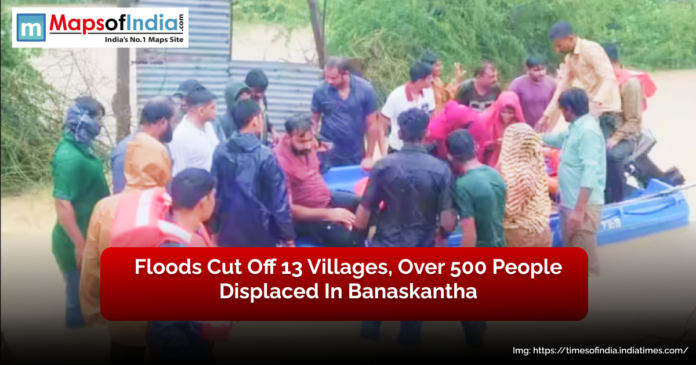The extensive destruction in parts of North Gujarat has been due to heavy rainfall, with the area of Santalpur – Radhanpur coming out as one of the most affected areas. Officials have estimated that almost 50,000 hectares of agricultural land have been affected, a heavy blow to farmers who were getting ready to observe the kharif season. Unremitting rainfalls have reduced fields into waterlogged areas, sweeping away standing crops and bringing doubt on the next harvest.
The Banaskantha district is especially worse off in Suigam taluka, where floodwaters have caused people to migrate to elevated places. Settlements that were formerly struggling with water shortage have been engulfed by swollen rivers and dams. Over 500 individuals have been displaced, and many have shifted to relief camps. There are over 13 villages in the region that have been isolated because of destroyed roads, which complicates the issue of supplying relief and medical care even further.
The severity of destruction does not apply to agriculture only. The infrastructure, too, has suffered big blows, as at least 258 electricity poles have been reported to have collapsed due to the force of strong winds and rain. This has resulted in darkness in more than 279 villages, making the problems of locals even harder. With the help of local bodies, relief agencies have whipped into action to deliver crucial supplies. Approximately 1.5 lakh food packets are made and given to families trapped in the problem areas.
Sudden overflow of two reservoirs in Santalpur in the Patan district also contributed to the crisis. Nightly discharge of water compelled the authorities to undertake an emergency rescue mission in Kalyanpura and other neighbouring villages, rescuing dozens of families stuck. The occurrences of such incidents underscore the weak position of flood preparedness in the area, where natural disasters could take a short time to overpower local resources.
According to the rain data, in almost all areas except Saurashtra, Gujarat has already obtained over 100 per cent of its average rainfall. On the one hand, this guarantees year-round water security, but on the other hand, it has raised the risk that rural belts are subjected to natural disasters. It is the roads, power supply systems and agricultural lands that have all been the recipients of the excess monsoon showers.
The situation is still under close observation of authorities, with rescue teams in place and more relief material being prepared. But to most in Santalpur, Radhanpur and Suigam, recovery will be a very protracted, up-and-down path. It will take months to restore crops, livelihood, and homes, as well as other infrastructure and the affected communities will be dependent on government aid and support in the immediate future.










